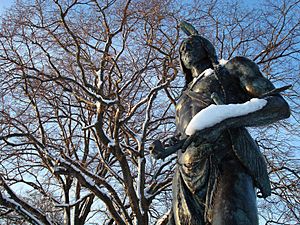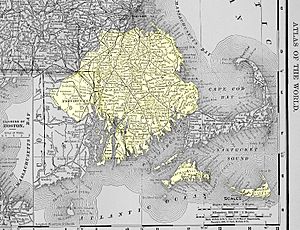Pokanoket facts for kids

|
|
| Total population | |
|---|---|
| defunct | |
| Regions with significant populations | |
| Massachusetts, Rhode Island | |
| Languages | |
| Wampanoag | |
| Religion | |
| Indigenous religion, Christianity | |
| Related ethnic groups | |
| other Wampanoag people |
The Pokanoket are an important group of Wampanoag people. They were led by Massasoit (around 1581–1661), who was a powerful chief, or sachem. Their main village was located at what is now Mount Hope in Bristol, Rhode Island.
Over time, the name Pokanoket came to mean all the people and lands ruled by Massasoit and the leaders who came after him. These lands were part of the larger Wampanoag territory in what is now Rhode Island and Massachusetts.
Contents
What Does "Pokanoket" Mean?
The name Pokanoket is also spelled Pauquunaukit. It comes from the Massachusett language. The name means "land at the clearing."
A Look Back at Pokanoket History
When the Pilgrims arrived in Plymouth, the Pokanoket lands were very large. They covered parts of Rhode Island and much of southeastern Massachusetts. European visitors wrote about the great power of the Massasoit, their "Great Leader."
Meeting the Pilgrims
The Pilgrims knew about the Pokanoket before their ship, the Mayflower, arrived in 1620. William Bradford, a Pilgrim leader, wrote about them. He heard that the Pokanoket were strong and had a bad feeling towards the English. This was because an English sailor had hurt many of their people in the past.
The main Pokanoket settlement was in an area now called Bristol, Barrington, and Warren in Rhode Island. Bradford was told this land had rich soil. It also had open ground perfect for growing English crops.
Early European Contact
In 1524, an explorer named Giovanni da Verrazzano sailed into Narragansett Bay. He saw people on the shores, who were likely Pokanoket. Verrazzano wrote that these Native Americans were "the most beautiful" and had "the most civil customs."
Peace and Help for the Pilgrims
The Pilgrims faced a very hard first winter. More than half of them died from sickness and hunger. The Pokanoket people helped them survive. They taught the Pilgrims how to plant local crops and how to live in this new land.
Even though the Pilgrims were scared at first, the Pokanoket quickly made a peace agreement with them. Bradford called the Pokanoket leader Ousamequin "their great Sachem, called Massasoit".
Pokanoket Leaders After Massasoit
After Massasoit Ousamequin, his sons became the Great Leaders of the Pokanoket. First, his son Wamsutta, also known as Alexander, took over. Then, his other son Metacomet, known as Philip, became leader. Metacomet was killed during a big conflict called King Philip's War (1675–76).
Important Pokanoket Leaders
| Leader | From | To |
|---|---|---|
| Massasoit Wasanegin | 1525 | 1577 |
| Massasoit Ousamequin | 1581 | 1661 |
| Massasoit Wamsutta (English name "Alexander") | 1661 | 1662 |
| Massasoit Metacomet (English name "Philip") | 1662 | 1676 |
Pokanoket Lands Through History
The map you see here shows what the Pokanoket ancestral lands might have looked like. This map was made by looking at old descriptions from the 1600s.
Today, these historical lands include many cities and towns. They are found along the border of Massachusetts and Rhode Island. Some of these places are Bristol, Warren, Barrington, East Providence, Seekonk, Rehoboth, and Attleboro.
Pokanoket Descendants Today
Today, some people who are descendants of the Pokanoket village are part of the Mashpee Wampanoag Tribe. This tribe is officially recognized by the U.S. government in Massachusetts.
There is also a group called the Pokanoket Tribe, or Pokanoket Nation. They say they are descendants of the Pokanoket people. However, this group is not officially recognized by the U.S. government or by any state. They are also not recognized by other Wampanoag tribes. The town of Warren, Rhode Island, does have a sign that recognizes their historical connection to the land.


